The Ultimate Sports Nutrition Guide for Athletes and Coaches
Calories | Protein | Carbs | Fat | Micronutrients | Hydration | Nutrient Timing | Sports-Specific Nutrition Guides
If want the winning edge, sports nutrition is your secret weapon.
More the just eating well, sports nutrition is a strategic way of eating that optimizes your athletic performance. It ensures your calorie, protein, carbohydrate, fat, vitamin, mineral, and fluid intake will meet the demands of your sport, the unique needs of your body, and your individual goals.
All so you can train your hardest, perform your best, and unlock your full potential as an athlete.
In this article, we’ll give you the essential sports nutrition strategies for peak performance, backed by scientific recommendations and practical advice.
Interested in advanced techniques like nutrient timing and post-workout nutrition? We’ve got you covered there, too—with our free sports-specific nutrition guides for dozens of sports.
Why is sports nutrition important?
The goal of sports nutrition is to ensure you’re well-hydrated, well-fueled, and well-nourished.
If you just take care of those three factors, you give yourself a serious edge.
That’s because you’ll improve your ability to gain strength, muscle, and endurance, recover faster between workouts and competitions, heal more quickly from injuries, and perform your best when it matters most.
But research shows that athletes rarely meet all of their nutritional needs.1 Even those who try to eat a healthy diet may not get enough fluids, calories, macronutrients, or micronutrients.2 This is true for everyone from youth athletes to professional athletes.
That might sound surprising, but because athletes expend so much more daily energy than non-athletes—and need to replace more nutrients and water for muscle repair and training adaptations—they often have a harder time achieving adequate nutrition, let alone optimal nutrition.
These nutrient deficiencies can2,3:
- reduce endurance
- decrease muscle strength and power
- increase recovery time
- reduce muscle mass
- increase body fat
The bottom line: Nutrient deficiencies are very common, and they can be detrimental to both health and performance.
Thankfully, you can fix any deficiencies and optimize your diet with the right information and plan.
The importance of sports nutrition for youth athletes
For adolescent athletes, being consistently well-fueled throughout the day is critical—not just for performance but for overall health and well-being, too. According to the Canadian Paediatric Society, chronic energy deficits can cause4:
- delayed puberty
- short stature
- menstrual dysfunction
- loss of muscle mass
- fatigue
- increased chance of injury or illness
To be sure, the challenge isn’t always just about knowing what and how much to eat. It’s also important to recognize that life circumstances can impact good nutrition. For example, youth athletes living in urban areas or in lower-income households may have difficulty getting regular access to high-quality foods, like fresh fruits, vegetables, and meats.
This guide to eating healthy on a budget can be a useful resource, but if you’re a coach who’s working with an athlete, it can also help to understand the problems presented by “food deserts” and “food insecurity.”)
Understanding athletes’ caloric needs
Because athletes burn more calories than the average person, they also require more calories. The importance of adequate energy intake reaches far beyond athletic performance.
When hard-training athletes don’t eat enough, they may experience a condition known as Relative Energy Deficiency in Sport, or RED-S.3,5,6 Besides leading to a decline in athletic performance, RED-S can negatively affect an athlete’s:
- menstrual cycle
- bone density
- immunity (getting sick a lot)
- cardiovascular health
- psychological health (particularly increased anxiety)
- growth and development (in young athletes)
How many calories do athletes need?
The number of calories you need as an athlete depends on your size, age, overall activity level, and goals. The easiest way to calculate your personal calorie needs is to use our nutrition calculator.
Just answer each question, and in less than a minute, you’ll have a sports nutrition plan that’s 100 percernt customized for your goals, including the amount of calories, protein, carbs, and fat you should eat.
(Note: When using the nutrition calculator, unless you already have specific preferences, we recommend you choose “athletic performance” as your goal, and select “anything” when it asks for your preferred eating style.)
Do athletes have to count calories?
Based on our experience coaching over 100,000 clients—including UFC Champ George St. Pierre, US Open Winner Sloane Stephens, and eight NFL, NBA, and NHL teams—the answer is no.
If you find it helpful and interesting, you certainly can count calories—it’s just not required.
What’s most important is that you nail the essentials. Many athletes who accomplish this don’t ever need more advanced (a.k.a. time-consuming) strategies like meticulously counting every morsel they eat.
The importance of macronutrients for athletes
Protein, carbs, and fat are known as macronutrients, or macros, and they’re key to nailing the essentials of sports nutrition. Getting the right amounts of each macronurient ensures you’ll have the energy and raw materials you need to perform your best and get the results you want.
Protein
Athletes need more protein than non-athletes. That’s because protein is necessary to repair the muscle damage caused by hard-training and intense competitions. When athletes don’t enough of this nutrient, it’s harder to build muscle, lose fat, and recover from practices, workouts, and games.
Protein also helps you:
- digest your food better
- make hormones (like growth hormone)
- maintain a healthy immune system
How much protein do athletes need?
Eat 0.65 to 1 gram of protein for every pound you weigh (1.4 to 2.2 grams per kilogram). Some athletes may benefit from slightly more protein, but this is a good target for most. This recommendation is based on research that shows this is the upper range needed to maximize muscle growth and training adaptations for most people.7,8
For example, if you weigh:
- 150 pounds (68 kg): Eat 100-150 grams of daily protein.
- 200 pounds (91 kg): Eat 130-200 grams of daily protein.
- 250 pounds (113 kg): Eat 160-250 grams of daily protein.
To make it easy, you can use your hand to track your intake. For example, one portion of lean protein—say, lean steak, chicken breast, or tofu—is the diameter and thickness of your palm and provides about 25 grams of protein. A scoop of protein powder is usually the same. (Check the product label to be sure.)
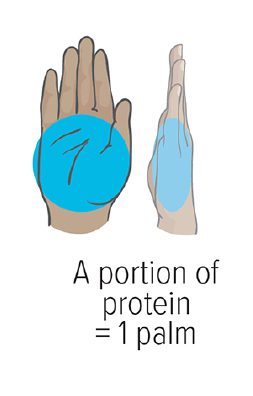
Based on this, a 150-pound (68 kg) athlete would need about 4-6 palms of protein each day.
(Here’s the math: 150 pounds of body weight x 0.65-1.0 grams of protein = 100-150 g protein. Then 100 g or 150 g of total protein / 25 g protein per palm-sized serving = 4-6 palms of protein per day.)
The best protein for athletes
Primarily, we recommend athletes emphasize minimally-processed sources of lean protein. That includes animal protein such as lean beef, chicken, turkey, and fish, and plant-based protein such as lentils, beans, edamame, tempe, and tofu.
But you don’t need to rigidly eat chicken breasts at every meal. Instead, think of your protein choices on a continuum, as shown in the protein food list below.
The idea: Most of your protein—about 80 to 90 percent—should come from the “Eat More” and “Eat Some” columns. The other 10 to 20 percent can come from whichever column you prefer. This provides you with flexibility while still allowing you to nail the essentials.
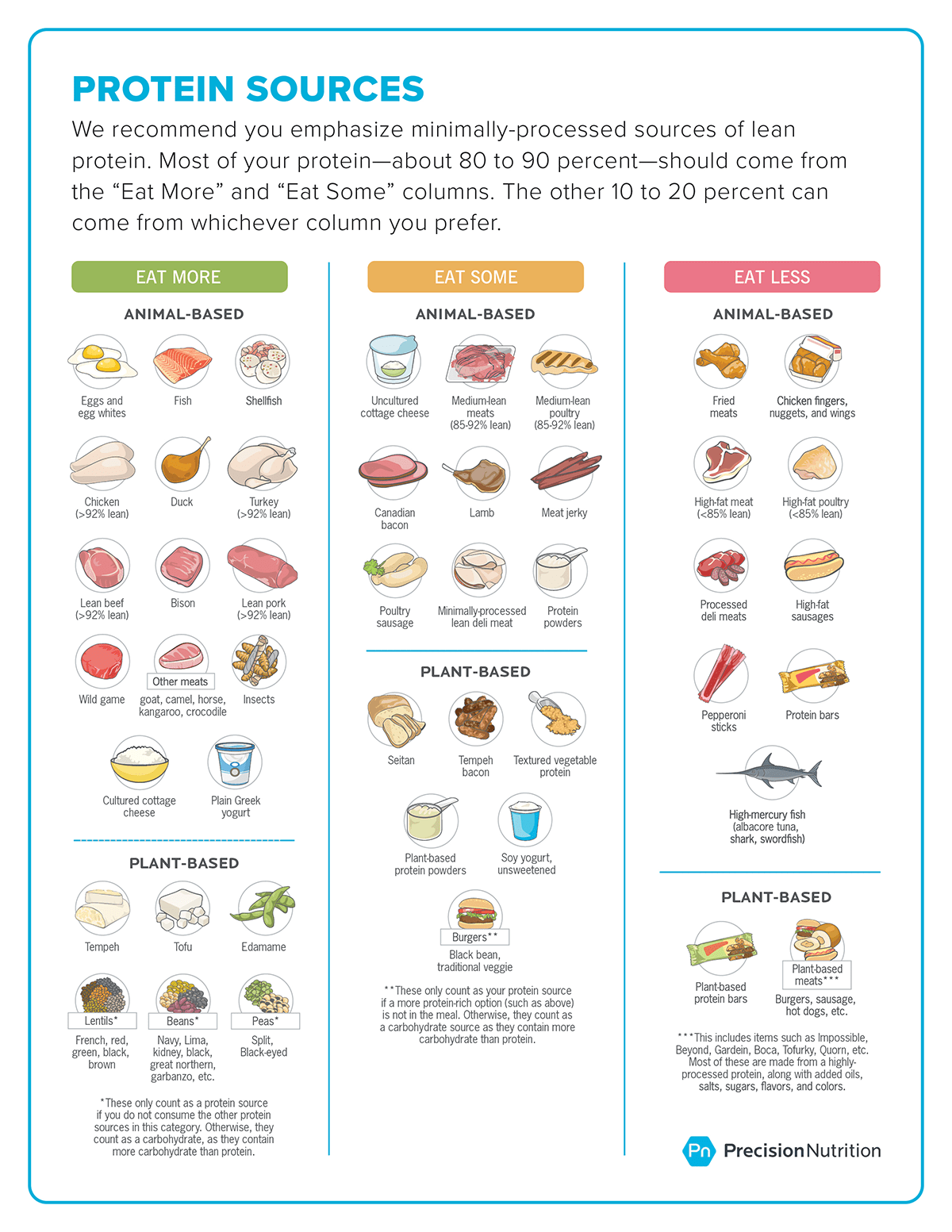
Carbohydrates
Athletes need carbs to be at their best. If you don’t get adequate amounts, your energy levels will suffer. This negatively affects not only your physical performance but also your mental performance—causing slower reaction times, poor decision-making, lack of focus, and deterioration of technique (think: throwing, shooting, and running mechanics).9
While you might have heard that low-carb diets help athletes, the body of scientific evidence just doesn’t support that.9 Rather, getting enough carbs is crucial for optimizing your performance, recovery, and body composition.
What’s more, eating carbs can also help you:
- keep your thyroid functioning well
- maintain healthy levels of sex hormones (testosterone for men; estrogen and progesterone for women)
- regulate your mood and emotions
- sleep better
How many carbs do athletes need?
Eat 2-3 grams of carbs for every pound you weigh (5-7 grams per kg).9
(That number is slightly higher—3-4 grams per pound (7-9 grams per kg)—for endurance-sport athletes, so if that describes you, get more precise recommendations in our sports nutrition guides.)
For example, if you weigh:
- 150 pounds (68 kg): Eat 300-450 grams of carbs every day.
- 200 pounds (91 kg): Eat 400-600 grams of carbs every day.
- 250 pounds (113 kg): Eat 500-750 grams of carbs every day.
As with protein, you can use your hand to track your intake. A portion of carbohydrate-rich foods—fruit, potatoes, grains, beans—is the size of your cupped hand and provides about 25 grams of carbs.
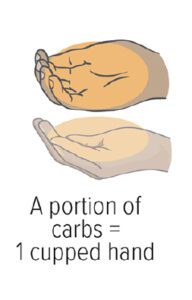
Based on this, a 150-pound (68 kg) athlete would need about 12-18 cupped handfuls of carbs each day.
(Here’s the math: 150 pounds of body weight x 2-3 grams of carbs = 300-450 g total carbs. Then 300 g or 450 g of total carbs / 25 g carbs per cupped-hand serving = 12-18 cupped handfuls of carbs per day.)
The best carbs for athletes
Choose high-quality carbohydrate-rich foods that are minimally processed. This includes any whole fruit, starchy vegetables such as whole potatoes and corn, a variety of whole grains (including oats, whole grain bread, and wild rice), and beans.
Use our continuum to guide your choices: About 80 to 90 percent of your carb intake should come from the “Eat More” and “Eat Some” columns in the carbohydrate food list below. The other 10 to 20 percent can come from whichever column you prefer. (Note: If you’re wondering about vegetables, check out “The importance of micronutrients” below—they have their own category.)
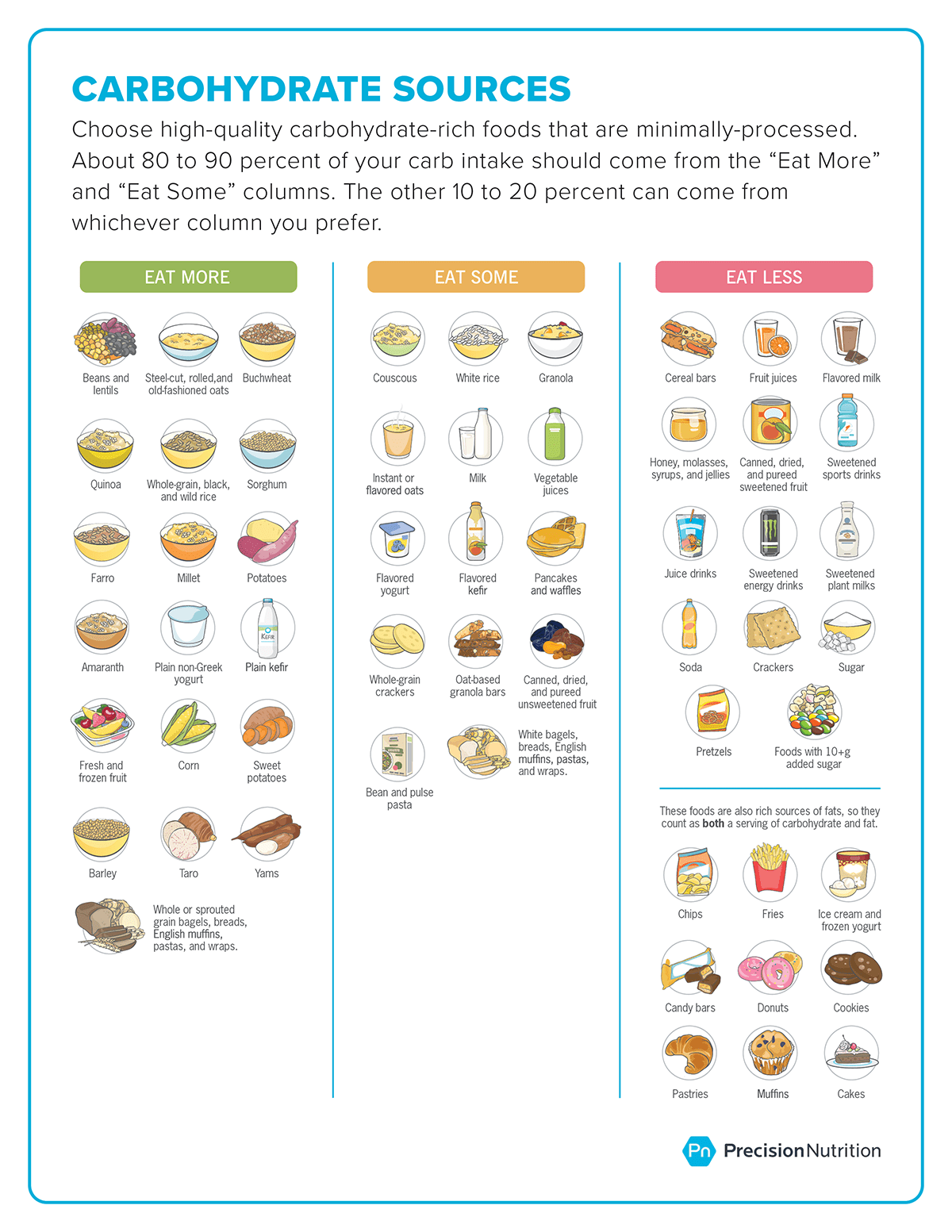
Fat
People used to think dietary fat made you fat, slowed you down, and caused heart attacks. But that’s not true: Especially if you focus on the right kind of fat.10
In fact, you need healthy fats to help11:
- burn body fat and build muscle
- your cells to work properly
- make sex hormones (like testosterone and estrogen)
- build a strong immune system
- absorb important nutrients like vitamins A, D, E, and K
How much fat do athletes need?
Eat about 0.5 gram of fat for every pound you weigh (1.1 grams per kg).
For example, if you weigh:
- 150 lb (68 kg): Eat about 75 grams of fat every day.
- 200 lb (91 kg): Eat about 100 grams of fat every day.
- 250 lb (113 kg): Eat about 125 grams of fat every day.
As with protein and carbs, you can use part of your hand to track your intake.
A portion of fat—for instance, nuts, peanut butter, olive oil—is the size of your entire thumb and provides about 10 grams of fat.
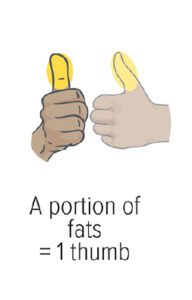
Based on this, a 150-pound (68 kg) athlete would need about 7-8 thumbs of healthy fats each day. (Here’s the math: 150 pounds of body weight x .5 grams of healthy fat = 75 g of healthy fat. Then 75 g of total health fat / 10 g fat per thumb-sized serving = 7-8 thumbs of fat per day.)
(Again, this is a good fat intake recommendation for many sports, but to get the numbers specific to YOUR sport, download the sports nutrition guide for your sport here.)
The best fats for athletes
We recommend that athletes eat mostly minimally-processed healthy fats. Aim for a mix of whole-food fats (like nuts and seeds), blended whole foods (like nut butter and guacamole), and pressed oils (like olive and avocado).
This doesn’t mean, however, that you can’t enjoy butter or bacon (in moderation). Your goal: You want 80 to 90 percent of your fat intake to come from the “Eat More” and “Eat Some” columns of the food list below. The other 10 to 20 percent can come from whichever column you prefer.
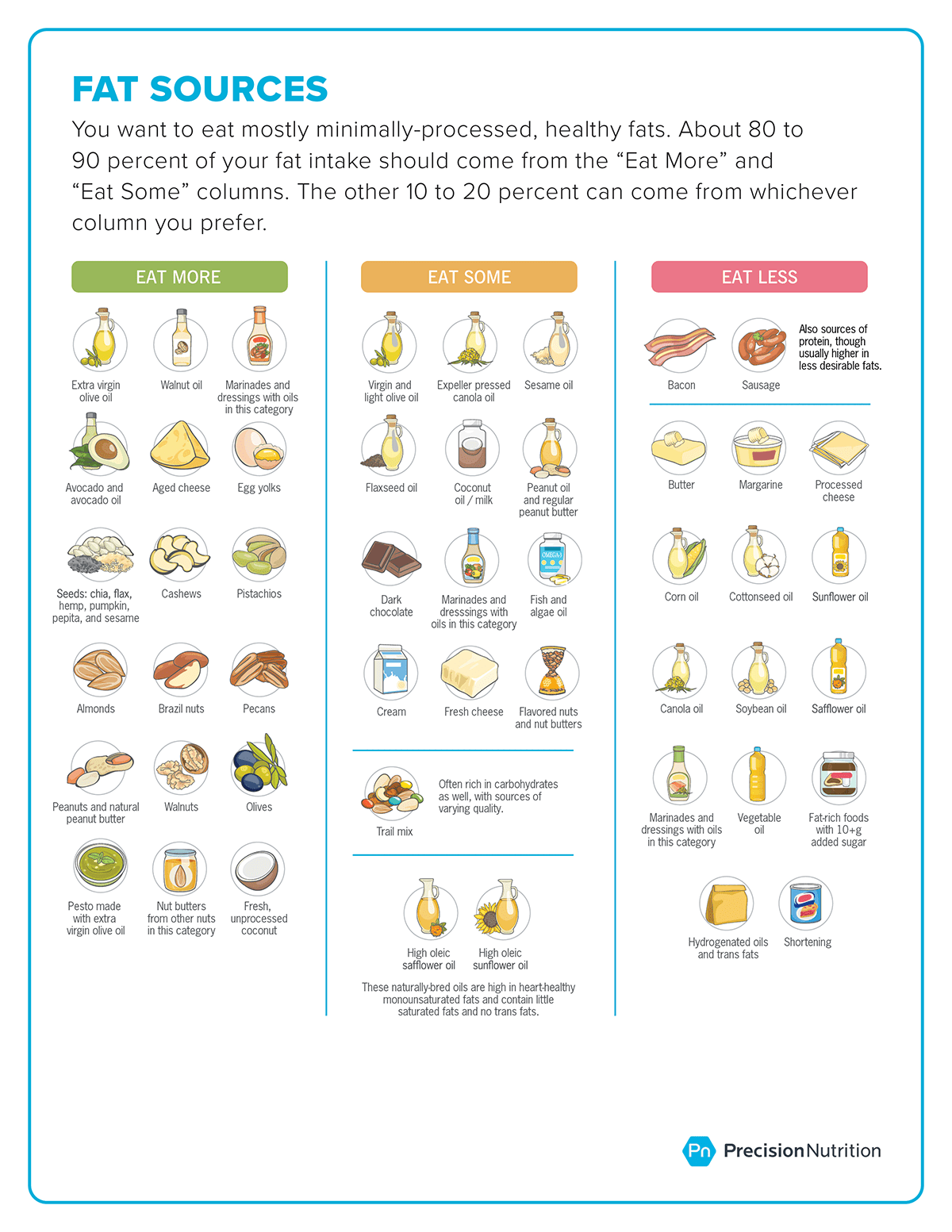
The importance of micronutrients for athletes
Intense athletic training and competition can deplete micronutrient stores.9 Micronutrients—which include vitamins, minerals, and phytonutrients (healthful substances found in plants)—are involved in hundreds of metabolic processes that influence energy levels, appetite, strength, endurance, and mood. So they’re critical for both performance and overall health.
Without enough micronutrients:
- you’ll get sick more often
- your brain function and coordination will decrease
- your muscle (and heart) contractions will be less powerful
- you’ll be weaker and your endurance will suffer
- you’ll suffer muscle cramps
- you’ll increase your risk of heart disease, cancer, diabetes, and more
What micronutrients do athletes need?
Athletes should consume a wide variety of micronutrients—to cover all nutritional bases—but they’re most often deficient in vitamin D, magnesium, zinc, and calcium. They also tend to come up short in phytonutrients.
There’s a relatively simple fix, though: Make sure your plate is full of colorful plant foods by “eating the rainbow.” Plant foods, in general, are rich sources of vitamins and minerals, and the colors and aromas in plants signify the presence of phytonutrients.
To help ensure you get all the micronutrients you need for optimal health and performance, we gave colorful, nutrient-dense vegetables their own category.
How to eat the rainbow
Hard-training athletes should try to eat at least 1 cup of each color (green, red, orange/yellow, blue/purple, white) of vegetables every day.
A portion of vegetables—spinach, tomatoes, cauliflower—is 1 cup or equal to the size of your full fist. To make things easy, you’ll probably get enough if you simply eat around 1-2 fists of vegetables with each meal.
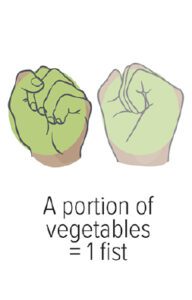
Use the food list below to guide your choices.
(Eating a variety of colorful fruit and starchy vegetables (like purple potatoes) also helps you “eat the rainbow,” though these foods live in the Carbohydrate category.)
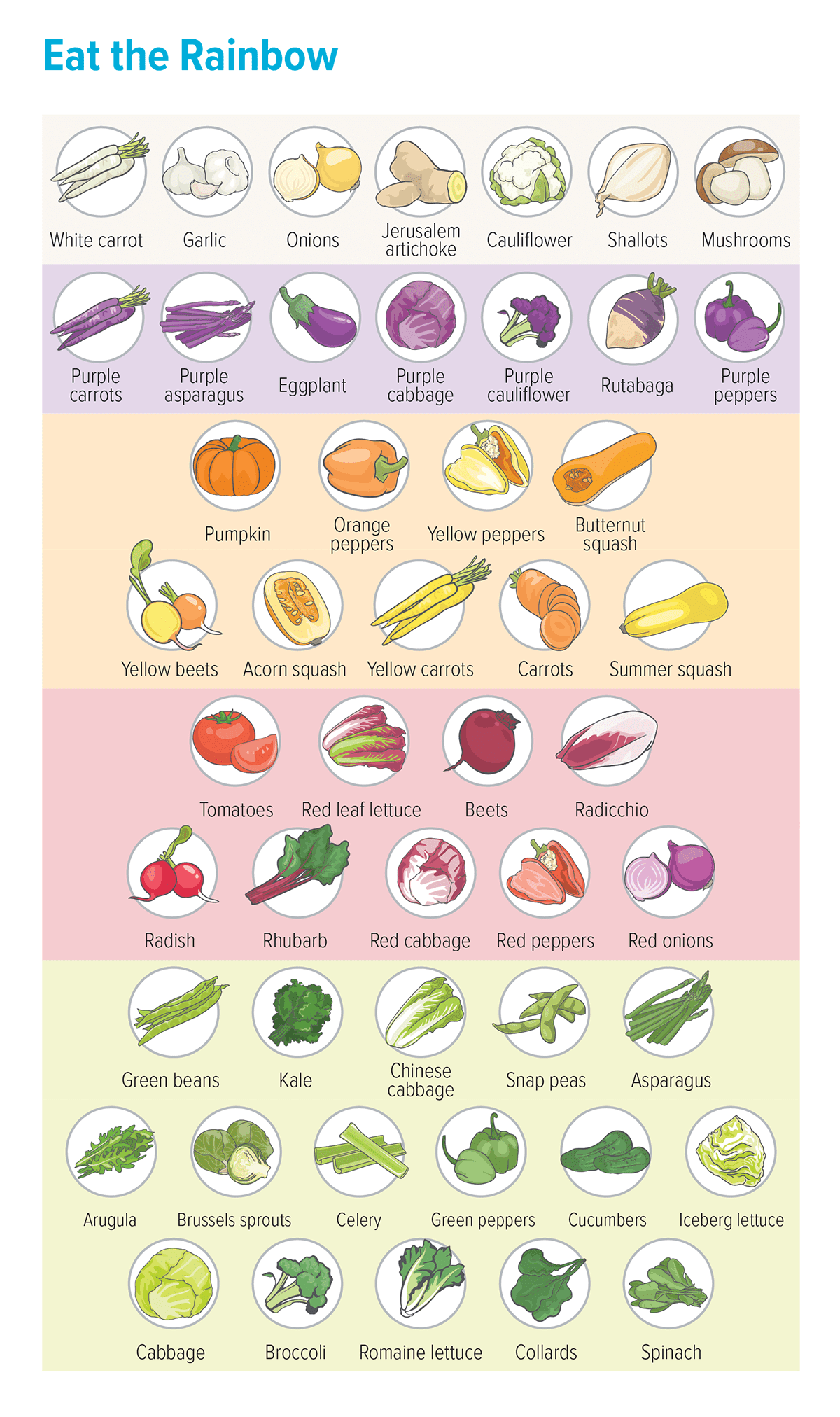
Understanding athletes’ hydration needs
This isn’t the most exciting topic, but it’s incredibly important. That’s because if you don’t drink enough water—and become dehydrated as a result—your health will decline, your metabolic rate will slow, and your athletic performance will tank.12
In fact, when you lose more than 1-2 percent of your body water—which can happen from just one hour of exercise in the heat—brain function diminishes, endurance drops, and strength and power decrease.12 What’s more, your heart can start racing during even relatively easy activities.
So it’s critical you drink enough.
How much water do athletes need?
Aim for 96 to 128 ounces (3-4 liters) every day.
Here’s how:
► Step 1: Fill a 32-ounce (1 liter) bottle and drink it during workouts and competitions.
► Step 2: Fill another 32-ounce (1 liter) bottle and drink it right after workouts and competitions.
► Step 3: Each time you eat a meal, drink another 8 to 16 ounces (0.25-0.5 liter) of water.
For basic hydration, plain water is fine. But if you’re training hard, you could add a powdered sports or recovery drink to these bottles.
You can assess your hydration status by comparing your urine color to the chart below.
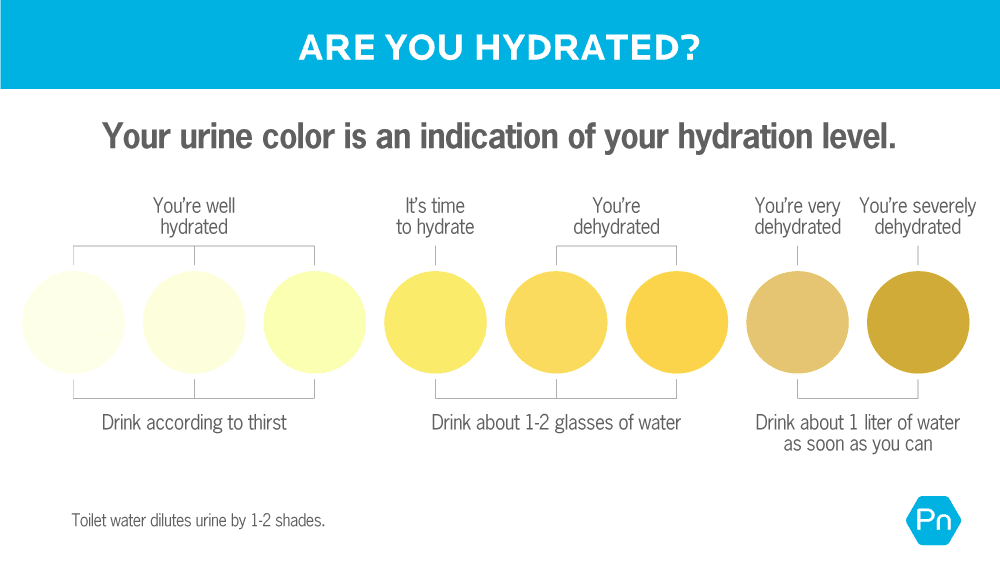
Urine color isn’t your only indicator of dehydration, though. If you’re working out or competing and start feeling a little confused, get a headache, tire quickly, become dizzy or light-headed when standing up, or feel really moody, these are early warning signs of dehydration. You need to start drinking.
Meal timing, nutrient timing, and pre-workout nutrition
If you’re consistently nailing the essentials of sports nutrition, you may benefit from some additional attention to meal timing / nutrient timing and pre-workout nutrition / post-workout nutrition. Consuming the right foods and fluids anywhere from a few hours to right before and after your workout or competition can help you13:
- Sustain energy
- Boost performance
- Stay hydrated
- Preserve muscle mass
- Speed up recovery
In our FREE sports nutrition guide, we’ll tell you everything you need to know about:
- pre-workout nutrition / pre-game nutrition
- in-workout nutrition / in-game nutrition
- post-workout nutrition / post-game nutrition
You’ll get detailed recommendations for what to eat, how much to eat, and when to eat to optimize performance for your sport.
What to do next
When you’re just starting out, optimal sports nutrition can often feel overwhelming. But it doesn’t have to be.
Our advice: You don’t need to adopt every practice and strategy at once. In fact, most athletes probably shouldn’t.
Instead, just add one new nutrition practice every 2-4 weeks, get good at it, and then add another. That’s how you make progress.
For example, maybe your approach looks like this:
- Weeks 1 and 2: Drink plenty of water.
- Weeks 3 and 4: Eat plenty of high-quality protein.
- Weeks 5 and 6: Eat plenty of high-quality carbohydrates.
- Weeks 7 and 8: Eat plenty of healthy fats.
- Weeks 9 and 10: Eat a rainbow of vegetables (and fruits)
By mastering one of these practices every couple of weeks—in order—you’ll be a totally different athlete. And not only that, you’ll have turned your entire eating program around without much hassle or stress.
Now, if you want even more specific nutrition recommendations for YOUR sport…
Download Your Free Sports Nutrition Guide
We’ve created FREE nutrition guides for dozens of sports that you can use to better customize your nutrition.
To be sure, many of the sports have almost identical nutrition recommendations. That’s because the energy demands of those sports are similar to each other.
Other sports, however, differ significantly. For example, the nutrition recommendations for marathoners is a lot different from those for golfers.
Each sports nutrition guide covers the essentials of sports nutrition, along with meal timing and workout nutrition. But they’ll also show you:
- How to lose fat
- How to gain muscle
- The best supplements
- How to eat well on the go
- How to choose healthy snacks
- And more
Sports-Specific Nutrition Guides
(Click on the link to download your free PDF sports nutrition guide)
If you love our sports nutrition guides, and are hungry to learn more about coaching athletes (or yourself) to peak performance, check out our Advanced Certificate in Nutrition Coaching for Athletes.
This specialized program includes three in-depth courses—How to Coach an Athlete, How to Create Personalized Nutrition Programs for Athletes, and How to Solve Common Nutrition Problems for Athletes— that’ll take your ability to coach athletes to an elite level.
References
Click here to view the information sources referenced in this article.
If you’re a coach, or you want to be…
You can help people build nutrition and lifestyle habits that improve their physical and mental health, bolster their immunity, help them better manage stress, and get sustainable results. We'll show you how.
If you’d like to learn more, consider the PN Level 1 Nutrition Coaching Certification.
The post The Ultimate Sports Nutrition Guide for Athletes and Coaches appeared first on Precision Nutrition.
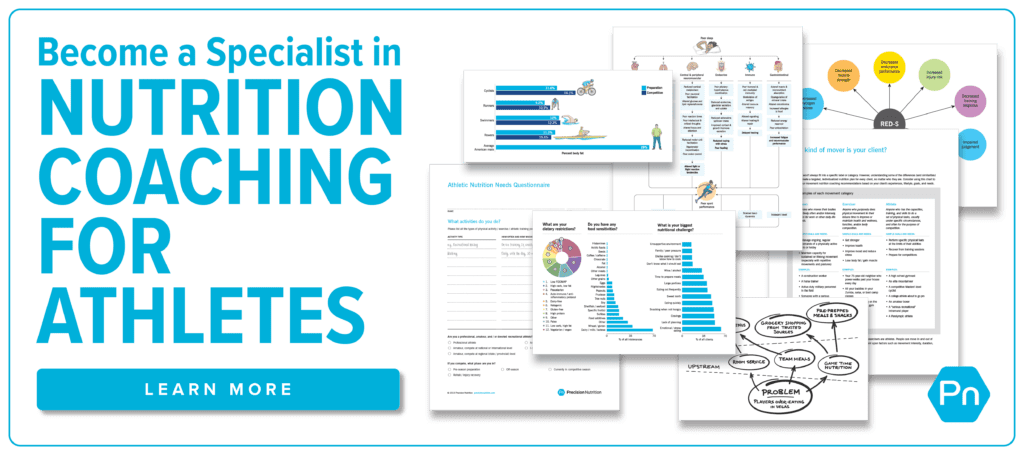

Nenhum comentário